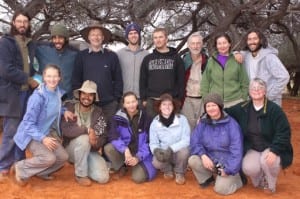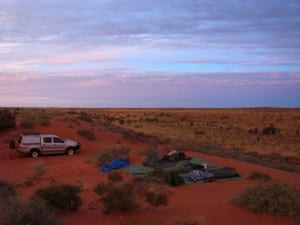Trapped in the desert – part three
By Jack Ashby, on 24 March 2011
A delayed account of zoological fieldwork in Australia – Part 9
From April 2010 I spent about five months undertaking several zoological field projects across Australia. I worked with government agencies, universities and NGOs on conservation and ecology studies ranging from Tasmanian devil facial tumour disease, the effect of fire, rain and introduced predators on desert ecology and how to poison cats. This series of blog posts is a delayed account of my time in the field.
Week Ten
Last week I went through some of the activities I was involved in when I joined a month-long field trip to southwest Queensland’s Simpson Desert with the University of Sydney. This week I want to talk about the people who I was with…
There were fourteen of us in all. Most were with the Desert Ecology Research Group at Sydney, here either as senior academics (Chris Dickmand and Glenda Wardle) and their operations teams or PhD students either collecting data for their own studies or taking time out to volunteer. Also they’d employed a freelance researcher to study the scientist/local community interaction and document the trip. The rest of us were unrelated volunteers, including a couple of zoologist museum folk, recent graduates in ecology, field ecologists from New Zealand and one person who’d just heard about the project on the radio and signed up to help.
Fourteen people together in the field seemed quite a lot to me, but when there’s just you for hundreds of square kilometres sharing everything for a month you get to know each other quite well.
_____________________
Arriving in the desert was genuinely jaw-dropping. I could roll off a dozen effusive clichés but it’s not worth it. This feeling certainly didn’t diminish over the month. I asked Bobby and Aaron, responsible for running the trips, whether after coming here four times a year every year it just feels like everyday work. I have a pretty nice job in our Museum at UCL, and I really enjoy it but I definitely consider it work. It was inconceivable to me that their answer would be yes, but it was. So Bobby and his extremely lucky colleagues have the best (and sandiest) office I’ve ever seen. But obviously, if you spend a quarter of your time working in the desert you’re going to consider it “work”.
They definitely weren’t complacent about it, but the longer you’re in a place the less new things you see.
Some of the PhD students and paid field assistants definitely haven’t reached this stage yet. George, James, Ido and Tony have each been here before, but they were constantly excited by nearly everything around them. While the wildlife, environment, atmosphere and camaraderie of a group huddled in the cold around a fire are fantastic motivators, I do think that there is a restricted portion of society that think that these things are worth giving up the comforts of roofs, phones, running water, beds, ovens, sofas, electricity, walls and toilets for an extended period of time.
Two members of the team, Hazel and Carol were there on holiday. That’s largely true of me too (a sabbatical), but the difference is that Hazel and Carol are both field ecologists from New Zealand. While I love my job, when I go on holiday I do fieldwork; I don’t go volunteering on learning and access programmes in zoology museums (that’s my job). The people here are all passionate about this stuff and it’s awesome.
Looking around a like-minded group I think that those that chose to be here were energised by spending time with people who understood. I use this word with no negative connotations, but a generally accepted term for people who are gaspingly passionate about something is “geek”. It goes without saying that we were all geeks. Have you ever noticed that when geeks get together they end up trying to out-geek each other? It’s whole new thing when you have the world experts there with you too.
And then there was Gemma, the researcher on the Iconic Landscapes project, documenting the trip and the way that the scientists engage with the local community (in this case mainly based at Bedouri, a few hours away). She did the same zoologising as everyone else there without playing the lone social scientist. In true Heisenberg style just having someone observe and engage you in what you were doing and how you felt about it – turning us into the subjects of study – made it all the more surreal.
Here’s a video she put together about it:
The thing is, there aren’t too many of the kind of people in the group around, and they should be celebrated. Seeing ecological research being done at the coal-face is quite removed from reading about the results. I’m amazed that nobody’s put fourteen passionate geeks alone in the middle of the desert and made a reality TV show of it. It’s probably because there’s no electricity.
It’s easy to imagine that the outside world is somewhat removed from what the team here, and Bush Heritage, were doing. In the next post I’ll look at the community engagement event organised through Iconic Landscapes, and what the local farmers think of these strange visitors.
UPDATE: PART TEN HERE
One Response to “Trapped in the desert – part three”
- 1
 Close
Close




[…] UPDATE: PART NINE HERE […]